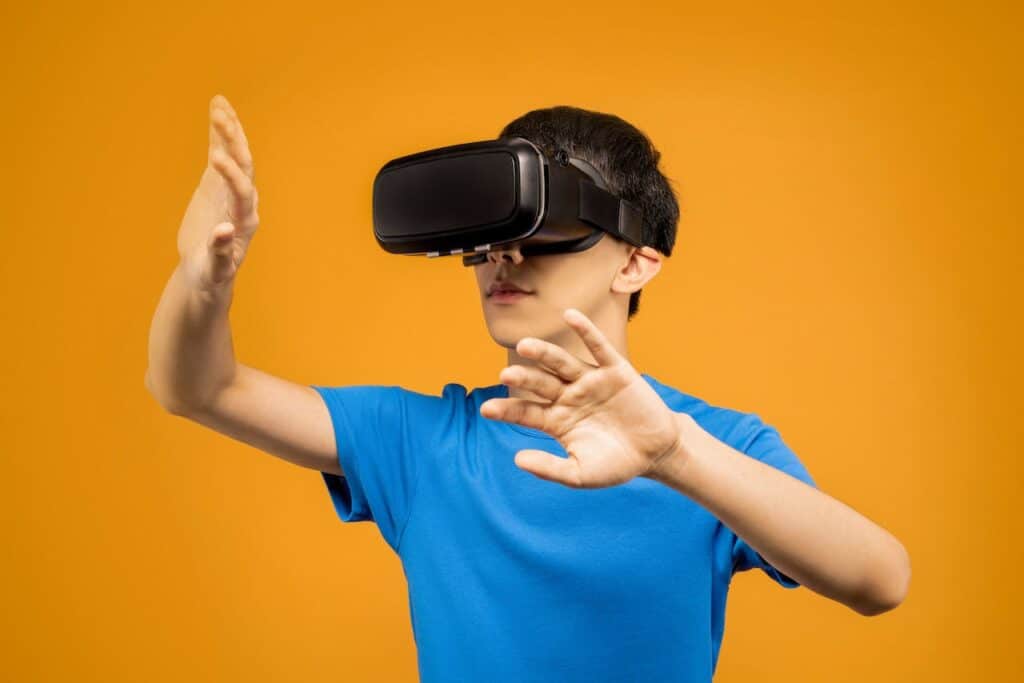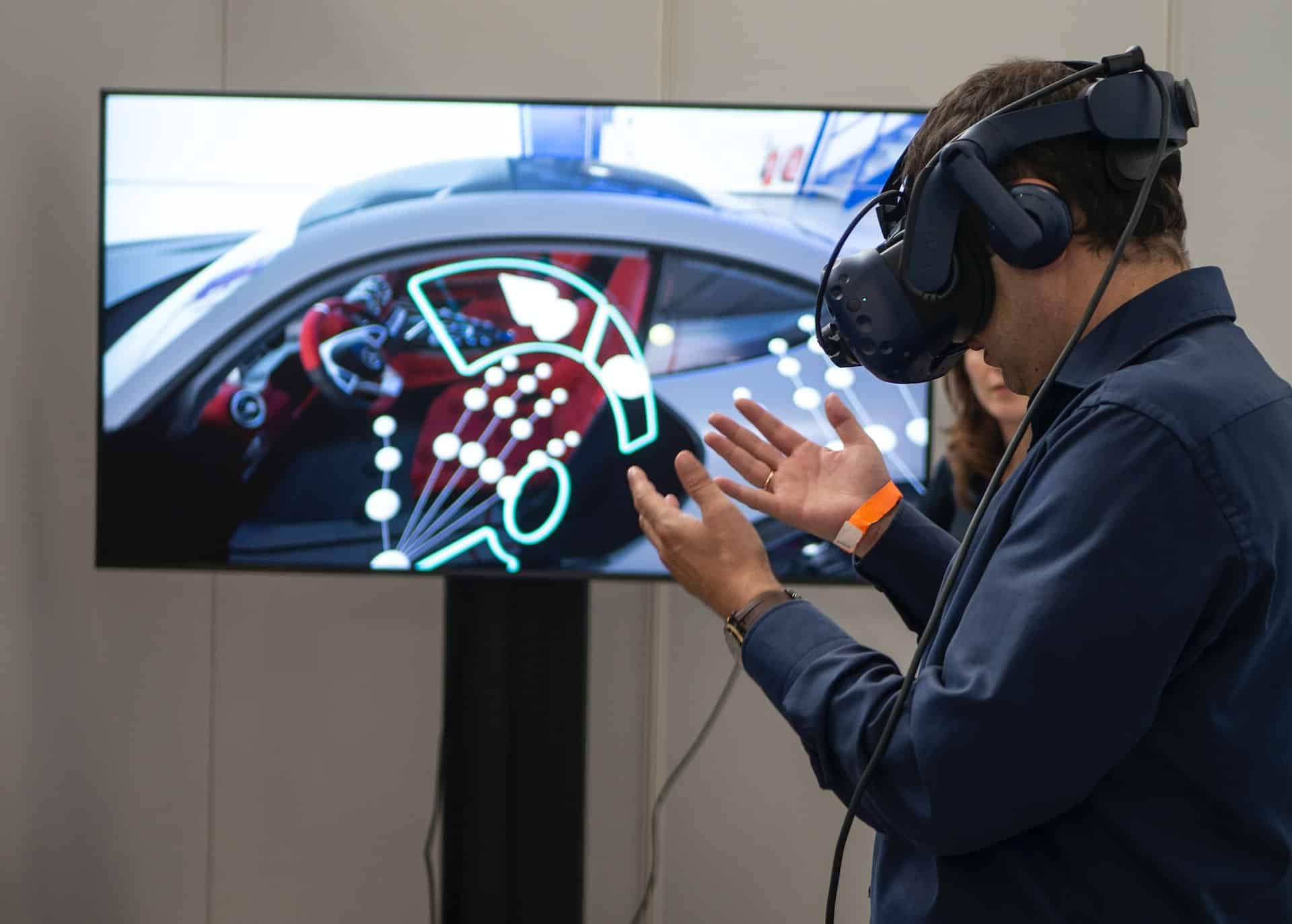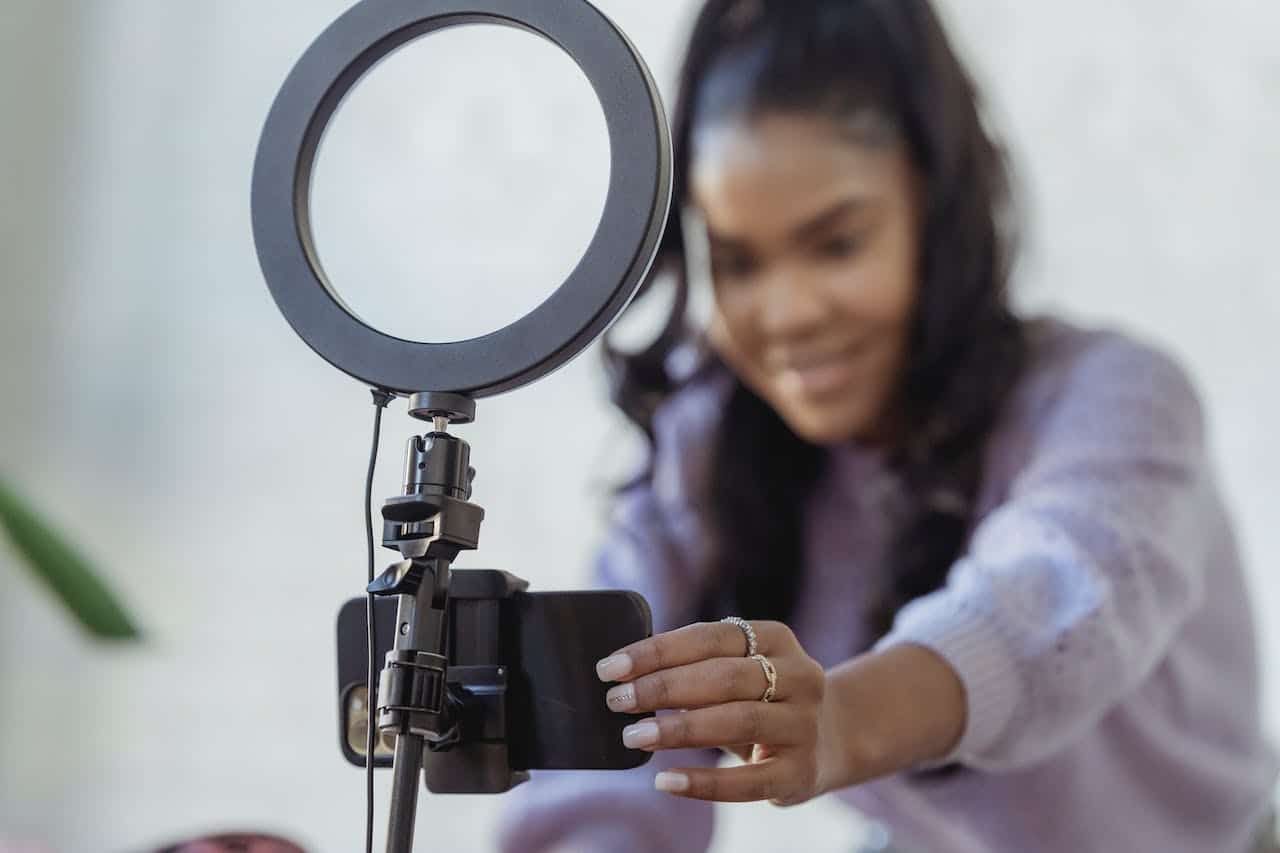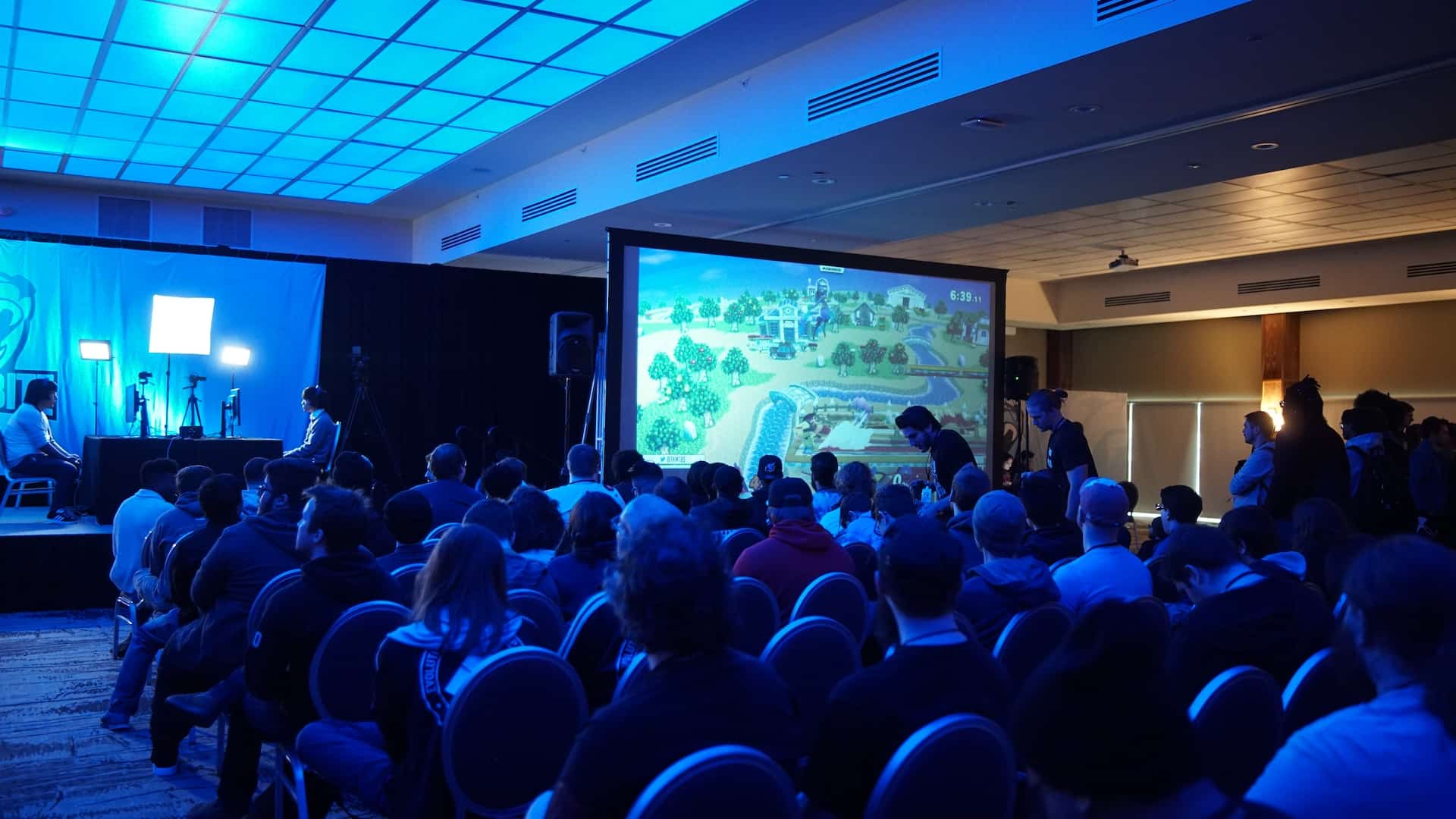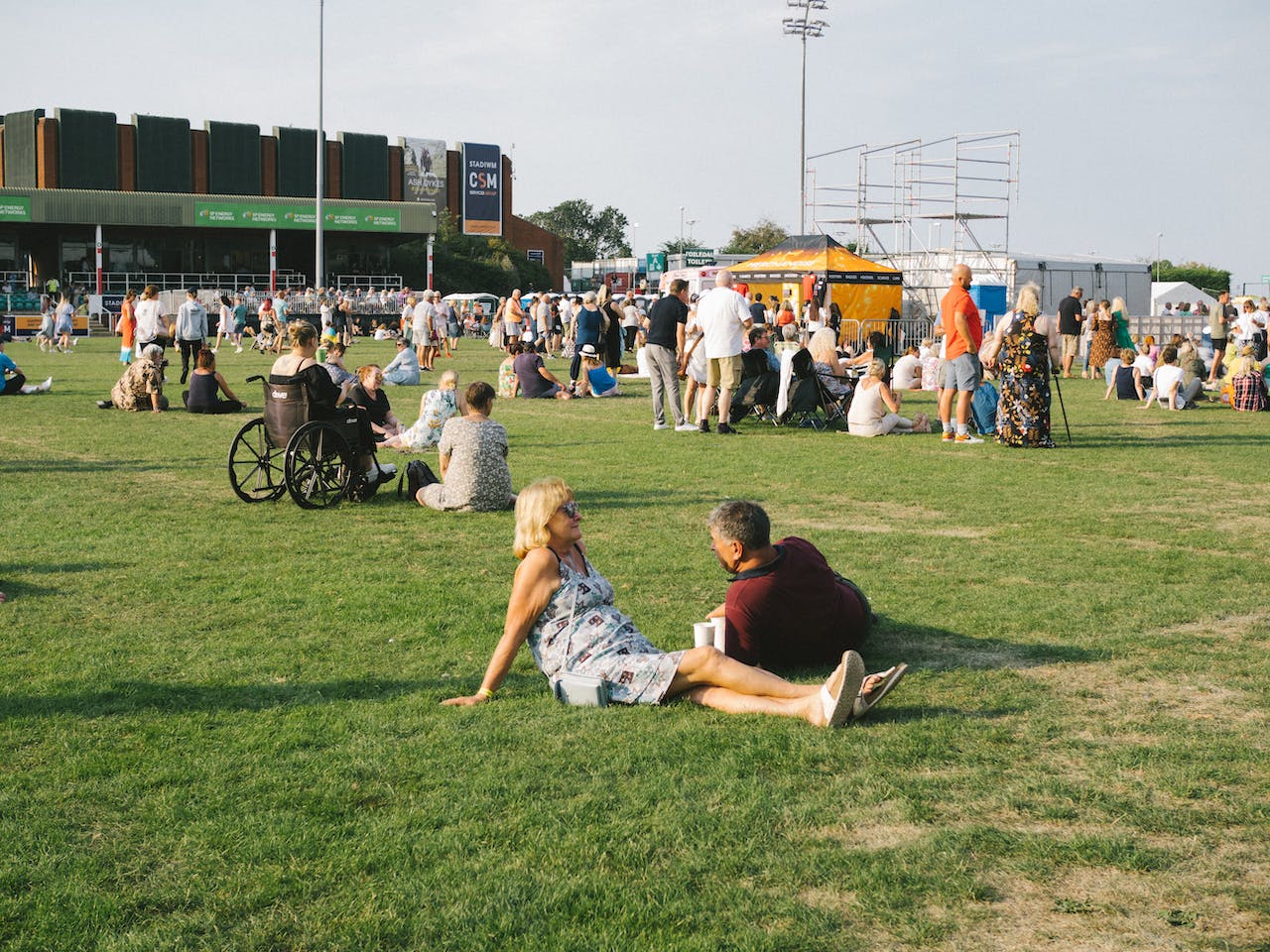Let’s face it. The world of event planning is changing. Gone are the days when simple decorations and a good sound system were enough to wow an audience. Today, it’s all about creating unforgettable, immersive experiences. This is where the magic of virtual reality (VR), augmented reality (AR), and mixed reality comes in, completely altering our perception of what an event can be. Learn more about immersive event technology and its impact on today’s corporate and social events.
The Magic of VR and AR in Events
Virtual Reality: Beyond the Physical Space
The advent of Virtual Reality (VR) in event planning is akin to unlocking a new dimension of possibilities. It’s a journey far beyond the traditional confines of physical spaces into realms where imagination dictates reality. Transforming a venue digitally goes far beyond mere replication. It marks a significant leap in redefining event possibilities.
Creating Immersive Virtual Worlds
VR technology enables the creation of fully immersive environments. Picture a corporate event in a virtual recreation of an ancient city or a product launch in a futuristic landscape. The possibilities are endless and thrilling. This immersive quality of VR makes it a powerful tool for storytelling and brand promotion, allowing companies to create unique, memorable experiences that resonate with their audience.
Global Reach, Personal Touch
One of the most striking benefits of VR is its ability to bridge geographical gaps. Attendees can join from anywhere worldwide, eliminating the need for travel and making the event more accessible. This global reach does not compromise the personal touch, however. VR can create intimate settings where attendees can interact meaningfully with each other and the environment.
Augmented Reality: A New Layer of Interaction
Augmented Reality (AR) transforms the event experience by adding a digital overlay to the physical world. It’s not a replacement for reality but an enhancement, a tool that adds depth and interactivity to the user’s environment.
Elevating Attendee Engagement
Imagine pointing a smartphone at a product during a trade show and watching it come to life with 3D animations, revealing its inner workings and features. This interactive element of AR makes it an invaluable tool for demonstrations and presentations. It provides a hands-on experience without physical prototypes, making complex ideas more understandable and engaging.
Customized Experiences for Every Attendee
AR also allows for personalization at a scale previously unattainable. Each attendee can have a tailored experience based on their interests and interactions. For instance, at an art exhibition, AR can offer detailed information about a specific artist to a curious attendee or suggest similar artworks based on their viewing history. This level of customization ensures that every participant has a unique, personalized experience, significantly enhancing their engagement and satisfaction.
Bridging Realities – The Role of Mixed Reality in Events
Mixed Reality: Merging Worlds for Enhanced Engagement
Mixed Reality (MR) is emerging as a groundbreaking force in the realm of event planning, standing boldly at the crossroads of Virtual Reality (VR) and Augmented Reality (AR). It’s a technology that weaves the fabric of the real and virtual worlds together, creating a tapestry of immersive and interactive experiences.
Creating a Cohesive Experience
MR’s power lies in its ability to seamlessly blend digital content with the physical environment. Imagine an architectural firm showcasing a building model. Through MR, this model can be explored in 3D by the attendees, walking around it, peering through its windows, and watching as the day turns to night to display lighting designs. This level of interaction is transformative, offering a depth of understanding and appreciation that static displays or traditional presentations can’t match.
Enhancing Emotional Connections
The beauty of MR in events is its potential to forge stronger emotional connections. When a product, concept, or story materializes in the same space as the viewer, the lines between observer and participant blur. Experiencing these events transcends mere observation and immerses you in feeling part of something much bigger. For instance, a charity event using MR can bring distant realities closer, making a far-off cause tangible and stirring empathy and action in ways traditional methods may not.
Real-Time Interaction and Feedback
Mixed Reality (MR) technology captivates with its visual prowess and excels as a tool for instant interaction and feedback. This dynamic two-way communication transforms attendees from passive viewers to active participants.
Interactive Learning and Engagement
Educational workshops and training sessions can leverage MR to create interactive learning experiences. Instead of just hearing about a concept, attendees can manipulate and experiment with it in a shared space. This hands-on approach makes learning more effective and enjoyable, leading to higher retention and a more profound understanding of the material.
Instant Feedback for Tailored Experiences
Real-time feedback is another gem in MR’s crown. During an event, organizers can gauge attendee reactions and adjust content on the fly. This adaptability ensures the event remains relevant, engaging, and in tune with the audience’s needs and interests. It’s a level of responsiveness that elevates the standard of personalized experiences in event management.
The Evolution of Event Marketing
Digital Strategies for Event Promotion
The domain of event marketing has seen a radical transformation driven by the unceasing progression of technology. This a complete overhaul of how events are promoted, transforming traditional methodologies into dynamic, digital strategies. In this digital era, tools like social media, digital marketing, and targeted advertising are not just accessories. Moreover, they are the mainstay of any successful event marketing campaign.
Leveraging Social Media for Maximum Impact
Social media has emerged as a powerhouse for event promotion, offering a far-reaching and intimately personal platform. Effective social media promotion of events involves much more than just sharing flyers. It’s about actively engaging and drawing in your audience. Social media marketing for events is a dance of engagement involving teasers, behind-the-scenes glimpses, and interactive content that builds anticipation and excitement.
On platforms like Instagram and Facebook, the ability to craft event pages, countdown stories, and host live Q&A sessions plays a crucial role in building a community feel, drawing potential attendees into a space where they feel a sense of connection and belonging. Twitter can be used for real-time updates, creating a buzz before, during, and after the event. LinkedIn excels in the professional sphere, connecting industry experts and facilitating networking opportunities.
Harnessing the Power of Targeted Ads and SEO
The digital world is data-driven, and this is where targeted ads come into their own. By analyzing user data, event marketers can create personalized advertising campaigns that accurately reach the right audience. Platforms like Google Ads and Facebook provide tools for targeting demographics based on interests, behaviors, and even geographic location, ensuring that your event promotion reaches those most likely to attend and engage.
Search Engine Optimization (SEO) plays a critical role, too. Event planners can enhance their visibility in search engine results by optimizing event websites and content with relevant keywords, attracting more organic traffic. This strategy involves deeply understanding the audience’s search habits and preferences and tailoring content to meet these insights.
Embracing Video and Influencer Marketing
The Rising Tide of Video Marketing
The emergence of video content as a dominant force in the digital realm has significantly influenced event marketing. Videos offer an engaging way to tell the story of your event, showcasing what attendees can expect in an informative and entertaining format. From promotional teasers to testimonials and highlights from past events, video content can significantly boost interest and engagement.
Influencer Collaboration: Expanding Reach
Partnering with influencers can exponentially increase the reach of your event. Influencers can introduce your event to a broader audience with their dedicated followers and credibility. This strategy involves collaborating with personalities that resonate with your target audience and leveraging their influence to create a buzz around your event.
The Yin and Yang of Tech Integration
Navigating the Challenges
The adoption of VR and AR in events brings a mix of exciting possibilities and noteworthy challenges. It’s a delicate dance of innovation and practicality, where the marvels of modern technology meet the real-world hurdles of implementation. Embracing these technologies opens up a universe of possibilities for event experiences. Yet, it also demands careful navigation through a maze of potential pitfalls.
Confronting Technical Complexities
The technical side of integrating VR and AR is often the first major challenge event planners face. These technologies require more than just the right hardware and software but also the expertise to wield them effectively. Ensuring compatibility with various devices, managing software updates, and providing stable, high-quality experiences are crucial. This aspect becomes even more complex when considering attendees’ diverse range of tech-savviness.
The solution lies in rigorous testing and a skilled tech team. The key to successful immersive experiences is blending their impressive visual appeal with dependability and ease of use. Partnering with experienced tech providers who understand the nuances of event-oriented technology can make a significant difference.
Budget Constraints and ROI Considerations
Budget is another critical factor. High-tech integrations can be expensive, and finding the balance between the wow factor and cost-effectiveness is key. The investment in VR and AR should be justified by a tangible return on investment (ROI), whether in terms of attendee satisfaction, brand exposure, or direct revenue.
Here, creativity and strategic planning are vital. Utilizing technology in events and maximizing the available resources is equally important. Sometimes, less is more if it aligns perfectly with the event’s objectives and audience expectations.
Balancing Immersive Event Technology with Human Interaction
Preserving the Human Element
Amid the rapid pace of tech innovations, the essence of any event still lies in the warmth and connection of human interactions. Technology should enhance, not replace, the personal connections and interactions that form the core of the event experience. This balance is where the magic happens – where high-tech meets high touch.
Creating Seamless Experiences
Our primary objective is to strive for a harmonious fusion of technology with the nuances of human interaction. This means technology should be intuitive and augment the event without becoming a distraction. It should facilitate networking, learning, and enjoyment, not hinder them. Ensuring that tech serves the event’s goals and enhances attendee engagement is essential.
Sustainability in the Age of Tech
Green Tech: Eco-friendly Event Solutions
The event industry stands at a crucial crossroads in an age where technology and sustainability are increasingly intertwined. The shift towards eco-friendly event solutions is a necessary evolution. As event planners and participants, we bear a collective responsibility to tread lightly on our planet. This responsibility has spurred a movement towards green technology in event planning – an approach that balances technological innovation with environmental consciousness.
Reducing Carbon Footprint with Virtual Events
One of the most significant advantages of technology in sustainable event planning is reducing the carbon footprint. Virtual events are a prime example. By hosting conferences, meetings, and even trade shows online, we significantly cut down on the greenhouse gas emissions associated with travel. Attendees from across the globe can participate without leaving their homes, making the event both accessible and eco-friendly.
Moreover, virtual events open the door to new possibilities regarding scalability and reach without the added environmental cost. They demonstrate that we can achieve global connectivity and collaboration without sacrificing our commitment to the planet.
Eco-friendly Event Management Tools
Beyond virtual events, a variety of eco-friendly event management tools are emerging. Digital invitations and ticketing reduce paper waste, while apps for event schedules and information minimize the need for printed materials. These tools streamline the event management process and align with a greener, more sustainable approach.
Sustainable technology also extends to the venues themselves. Energy-efficient lighting and sound systems, digital signage, and waste reduction initiatives are all part of creating an eco-friendly event space. Selecting technology and partners should always align with a shared dedication to eco-friendly practices.
Embracing a Holistic Approach to Green Technology
Educating Stakeholders and Attendees
An essential aspect of sustainable event planning is educating stakeholders and attendees about the importance of eco-friendly practices. This involves highlighting the environmental impacts of traditional event methods and the benefits of green technology alternatives. Event planners can encourage more sustainable choices across the industry by fostering awareness and understanding.
Innovating for a Sustainable Future
The journey towards sustainable event planning is an ongoing process of innovation and adaptation. As technology evolves, so do the opportunities to integrate greener solutions into every aspect of event planning. The potential for improvement is vast, from recycling initiatives to using renewable energy sources.
Enhancing Accessibility in Events with Technology
Inclusivity: Making Events Accessible to All
Technology in the sphere of event planning is about creating visually stunning experiences or streamlining processes. Additionally, it delves deeper into enhancing the overall event dynamics. It carries a deeper, more profound responsibility – the mission to make events inclusive and accessible to all. With the advances in technologies like Virtual Reality (VR) and Augmented Reality (AR), we are now equipped to dismantle barriers that traditionally limit participation, especially for people with disabilities. This evolution in immersive event technology is crucial to inclusivity, ensuring every individual can engage fully in the event experience.
Empowering Participation with AR and VR
Augmented and Virtual Reality revolutionize event planning by fostering environments that welcome a broader range of participants. AR can transform the event experience for the hearing impaired with real-time captioning and sign language interpretation overlays. Imagine an AR application that can translate a speaker’s words into text in real time, displayed through smart glasses or a mobile device. This immersive event technology not only aids in understanding but also enriches the experience for those who might otherwise miss out on crucial aspects of the event.
VR, on the other hand, opens doors for those with physical limitations. By creating immersive virtual environments, VR allows individuals who are unable to attend in person to experience the event as if they were there. This could be a virtual tour of an art exhibit for someone unable to navigate the physical space or a front-row seat at a concert for someone who can’t attend due to health constraints. VR’s sense of presence and participation is a game-changer, making events more accessible and inclusive.
Breaking Down Barriers with Assistive Technologies
Technology for Mobility and Accessibility
Beyond AR and VR, myriad other technologies are pivotal in enhancing accessibility. Ramps and automatic doors are necessities, but technology takes this further with advanced mobility solutions like stair-climbing wheelchairs and robotic exoskeletons for events held in locations not traditionally accessible.
Assistive Listening and Visual Aids
Assistive listening devices (ALDs) and visual aid technologies are essential for individuals with visual and auditory challenges. ALDs can amplify sound for attendees with hearing impairments, while screen readers and Braille displays can make digital content accessible to the visually impaired.
Looking Ahead: Future Trends in Immersive Tech
Immersive event technology is a canvas of endless possibilities, continuously evolving and pushing the boundaries of how we experience and interact with the world around us. These innovative technologies open new ways of engaging and captivating audiences in events. As we peer into the future, several groundbreaking trends are poised to revolutionize the event experience further.
AI-Driven Personalization: Crafting Unique Experiences
Integrating Artificial Intelligence into immersive event technology is one of the most thrilling developments. AI’s capability to analyze data and learn from user interactions opens up a world of personalization previously unimaginable. Imagine attending an event where every aspect, from the content you see on the displays to your interactions with virtual assistants, is tailored to your interests and preferences.
This level of personalization means that all attendees might have different experiences at an event. For instance, AI could curate information booths in real-time, presenting topics based on an individual’s past interactions and expressed interests. This bespoke approach enhances the attendee experience and provides valuable data to event organizers, allowing them to refine and improve their offerings continuously.
Tactile Experiences Through Haptic Feedback
The future of immersive technology also beckons the integration of haptic feedback, which brings a tactile dimension to virtual experiences. This technology simulates the sense of touch, allowing users to ‘feel’ digital objects and environments. In the context of events, this could mean physically interacting with a product in a virtual trade show or feeling a speaker’s handshake in a virtual meeting room.
Haptic feedback adds an incredibly rich layer to the virtual experience, making it more engaging and realistic. These innovations offer experiences far beyond visual and auditory stimulation by merging digital and tangible realities.
The Advent of 3D Holography
3D holography is another technology that’s set to transform the event experience. This technology can project lifelike 3D images into the physical space, making it possible for speakers, performers, or products to appear as if they’re present. Imagine a keynote speaker giving a speech as a 3D hologram, visible from all angles and able to interact with the audience in real time.
This immersive event technology can bring engagement and a wow factor to events that traditional video or in-person presentations cannot match. This technology gracefully intertwines the real with the virtual, crafting extraordinary experiences to captivate and immerse audiences in previously unimagined ways.
Crafting Personalized Experiences
Tailoring Events with AI and Data Analytics
In the current climate of event planning, the expectation for personalized experiences has become the norm, elevating beyond mere luxury. Attendees no longer want generic experiences. Today, they crave events that speak directly to them that resonate with their individual preferences and interests. With Artificial Intelligence (AI) and data analytics in the mix, we’re witnessing a significant transformation. What was once an overwhelming deluge of data is now being sculpted into unique, tailored experiences for every participant, making each interaction more personal and relevant.
Harnessing Data for Deep Insights
The first step in crafting personalized experiences is understanding your audience deeply. AI and data analytics tools sift through mountains of data – from past event interactions and social media behavior to survey responses. This analysis reveals patterns and preferences, offering a granular view of what each attendee might find engaging.
Imagine an event where registration involves questions about the attendees’ interests and past event experiences. AI then uses this data to tailor the event schedule for each attendee, suggesting breakout sessions, networking opportunities, and even food choices that align with their preferences. This level of personalization makes each attendee feel valued and understood, significantly enhancing their event experience.
Predictive Personalization
Beyond analyzing past behaviors, AI and data analytics can also predict future preferences. This predictive personalization involves using machine learning algorithms to anticipate what attendees might enjoy, even before they know it themselves.
For example, if data shows that an attendee has shown a keen interest in sustainability topics at past events, AI can recommend sessions focusing on green technology at an upcoming tech conference. This proactive approach not only enriches the attendee experience but also helps in building long-term engagement and loyalty.
Creating Dynamic, Adaptive Event Environments
Responsive Environments
The power of AI and data analytics extends to creating dynamic, adaptive event environments. With insights from real-time data such as session attendance and attendee engagement, we can fine-tune every aspect of the event, from ambiance and lighting to the selection of music, aligning with the mood and preferences of our audience.
Interactive Elements for Enhanced Engagement
Adding interactive elements like digital kiosks or mobile apps that use AI to provide personalized information further elevates the attendee experience. These tools can offer recommendations, assist networking by suggesting people with similar interests, or even adjust the event itinerary in real-time based on ongoing feedback.
The Human Touch in a Digital World
Balancing Tech with Human Elements
Amidst the surge of tech advancements, it’s essential to hold onto the notion that the true essence of an unforgettable event is rooted in the human connection. The digital revolution in event planning has brought countless innovations. Yet, the essence of events remains rooted in human connection and interaction. The enchanting interplay between innovative technology and the warmth of human interaction is the cornerstone of truly magical events. It’s a balance that ensures events are not just technologically impressive but also emotionally resonant and genuinely impactful.
Enhancing, Not Replacing Human Interaction
As we integrate cutting-edge technologies like AR, VR, and AI into events, the goal should always be to enhance, not replace, the human elements. For instance, while virtual reality can transport attendees to different worlds, the shared experiences, laughter, and conversations in these virtual spaces leave a lasting impression. Immersive event technology should be a bridge that connects people, a tool that facilitates deeper engagement and interaction, rather than a barrier that isolates them in digital silos.
Similarly, automation in event management should free up time for organizers to engage more personally with attendees. Automated registration systems, chatbots for information dissemination, and AI-driven analytics are excellent for efficiency. However, they should complement, not substitute, the personal attention, empathetic understanding, and warm welcomes that form the foundation of a great event experience.
Crafting Meaningful Digital Interactions
Technology as a Medium for Storytelling
One of the most powerful uses of technology in events is as a medium for storytelling. Whether through immersive AR experiences that tell a brand’s story or through VR scenarios that simulate real-world situations, technology should be employed to create narratives that resonate on a human level. The stories we tell through these mediums should evoke emotions, provoke thoughts, and inspire actions.
Facilitating Real Connections in Virtual Spaces
Even in wholly digital environments, the focus should be on facilitating real, meaningful connections. Networking tools in virtual events should be designed to mimic the dynamics of in-person interactions, encouraging spontaneous conversations and authentic exchanges. Features like breakout rooms, virtual lounges, and interactive Q&A sessions can recreate the organic networking and learning environment of physical events.
The Evolution of Networking in Virtual Spaces
Virtual Networking: Connecting in the Digital Age
Networking, the heartbeat of many events, has undergone a transformative shift with the advent of immersive event technology. In this digital age, the art of forming connections has transcended physical boundaries, thanks to virtual spaces. These spaces offer unique, innovative ways for individuals to connect, share, and grow their networks beyond what traditional events could offer. This evolution marks a new era in networking, where the limitations of geography, time, and physical presence are no longer barriers to meaningful interactions.
Redefining Interactions in Virtual Environments
Virtual Reality (VR) and other digital platforms have redefined networking. Picture a VR environment simulating a networking lounge or a conference hall. Here, attendees from across the globe can interact as if they were in the same room. Digital platforms are redefining the art of connection, facilitating a space where users can have impactful conversations, share thoughts, and work together effortlessly. This digital evolution dissolves the traditional boundaries set by distance and location, bringing people closer in a virtual yet very real way.
The true beauty of this technological leap is not just in mirroring in-person networking but in elevating it to new heights of connectivity and interaction. The awkwardness of physical networking events can be mitigated in these virtual spaces. Introverts or those new to an industry can find it easier to initiate conversations in a virtual setting. Moreover, features like real-time language translation can break down language barriers, fostering a more inclusive networking environment.
The Power of Virtual Business Cards and Profiles
The traditional exchange of business cards has also found its digital counterpart. Virtual business cards in these environments can be more dynamic and informative. Imagine clicking on a virtual card and being directed to a detailed professional profile, a portfolio, or even a brief introductory video. This depth of information facilitates more meaningful connections and follow-ups.
These virtual networking spaces also often have tools to efficiently manage and organize new connections. Attendees can categorize contacts, make notes, and schedule follow-up meetings all within the same platform, streamlining the networking process significantly.
Enhancing Networking with AI and Data Analytics
AI-Driven Matchmaking
Artificial Intelligence (AI) in virtual networking spaces can act as a matchmaker, connecting individuals based on shared interests, complementary skills, or mutual professional needs. This AI-driven matchmaking ensures that attendees connect with the most relevant individuals, maximizing the value of their networking efforts.
Analyzing Interactions for Continuous Improvement
Understanding and enhancing virtual networking hinges significantly on insightful data analysis, turning numbers and trends into meaningful improvements. By analyzing interaction patterns, event organizers can gain insights into what works and doesn’t, allowing them to refine the virtual networking experience continually. This could involve tweaking the virtual environment layout, enhancing communication tools, or altering networking session timing to suit attendees’ preferences better.
Frequently Asked Questions About Immersive Technologies
1. How is Virtual Reality (VR) transforming the event experience?
VR is revolutionizing events by creating immersive environments that transcend physical boundaries. Attendees can experience a venue or activity as if they are physically present, regardless of location. This not only enhances accessibility but also adds a novel dimension to events, allowing for creative and engaging experiences that were previously unimaginable in traditional settings.
2. Can Augmented Reality (AR) be used in any event?
Absolutely! AR can be integrated into various events, from trade shows and exhibitions to educational workshops. It adds a digital layer to the real world, enhancing the physical environment with interactive elements. For example, AR can bring product demonstrations to life at trade shows or add interactive, educational components to museum exhibits, making the event experience more engaging and informative.
3. What are the key challenges in integrating immersive technology into events?
Integrating immersive event technology, such as VR and AR, into events can pose challenges like technical complexities, budget constraints, and ensuring user accessibility. Successful integration requires thorough planning, understanding the target audience, and balancing technological innovation with practical considerations. Choosing the right technology partners is also crucial to address these challenges effectively.
4. How does immersive technology make events more inclusive and accessible?
Immersive event technology, particularly VR and AR, opens new avenues for inclusivity and event accessibility. VR can create experiences accessible to people with physical limitations, while AR can aid individuals with sensory impairments, like providing real-time captioning for the hearing impaired. These technologies ensure that more people can participate and engage in events, regardless of their physical abilities.
5. What future trends in immersive event technology should event planners be aware of?
Event planners should monitor trends like AI-driven personalized content, haptic feedback for tactile experiences, and advances in 3D holography. These technologies promise to personalize event experiences further, create more interactive and tactile environments, and provide lifelike presentations. Staying abreast of these trends will help planners create more innovative, engaging, and memorable events.
Connecting with EMRG Media for Immersive Event Technology
As we conclude our journey through immersive event technology, let’s reflect on its purpose – not just to utilize technology for its own sake but to forge engaging, memorable experiences that deeply resonate with participants. If you want to revolutionize your next event with the latest in VR, AR, and mixed reality, let EMRG Media be your guide. We’re here to infuse all your New York events with brilliant event technology, ensuring your event is an occasion and an experience to remember.

